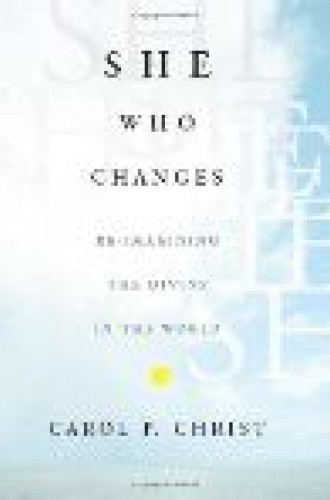She Who Changes: Re-Imagining the Divine in the World
When Carol Christ’s mother was dying, with her husband and daughter flanking the death bed, Christ felt a sensation she had never before experienced: the room was flooded with love. From that moment on, she has understood that “love is the ground of all being,” and that no matter what happened to her mother or to her, “love would never abandon either one of us.” On this vividly relational and experiential foundation Christ has built an inclusive contribution to contemporary religion and women’s spirituality. She constructs a sturdy bridge between Charles Hartshorne’s process theology and feminist thought.
It is ironic to find one of the foremost leaders of goddess religion admitting that she has “fallen in love” with a male philosopher, “a small man with a heart large enough to imagine freedom.” (Hartshorne cared so much about treating women fairly that, at age 99, he went back to his old essays and corrected them.) Interacting with such Hartshorne concepts as “inclusive monotheism” and “panentheism,” Christ argues that “now the time may be . . . right . . . for sustained and shared philosophical reflection by feminists in religion.”
While denying that divine power is ever coercive, “inclusive monotheism” refers to a Goddess/God (Christ’s terminology) who cares deeply about all suffering, rather than preferring one group to another. “Panentheism” means that the world is “in” Goddess/God (because of infinite divine love and sympathy) and that Goddess/ God is “in” the world, which is her/ his body. Divine love is the unifying principle that keeps the universe from decaying into chaos. And “’dual transcendence” means that Goddess/ God has an unchangeable nature that is consistently, creatively loving, but is also involved in a changing world, rejoicing in our joy and suffering in our pain, and working with us as co- creators of the future.
Although Christ does not say so, these points are not absent from the Hebrew and Christian scriptures. Acts 10:34 quotes Peter’s realization that “God shows no partiality,” a realization that should silence any claim that God is only on our side. Ephesians 4:6 affirms that there is “one God . . . of all, who is above all and through all and in all.” Colossians 1:17 declares that “in [Christ] all things hold together.” Multitudes of passages proclaim that God is relational, compassionate and involved with the creation (Psalm 111:4, for instance). And Genesis 1:28 records God’s commissioning of humankind to be co-creators with their Creator.
Christ’s reconciliation of traditional polarities is both fascinating and enlightening: pantheism and monism versus polytheism and plurality, for instance, or anthropomorphism versus the “negative way” that teaches the relativity of all imagery concerning God. Six of her chapters deal with basic mistakes of traditional theology. Each ends with some variant of the question, “Is it possible that this error arose because of attitudes toward women, whose body-identification and secondary status were unquestioned?” Each time the question is repeated, its resonance deepens.
I wish that Christ had wrestled a little more with the possibility that although omnipotence has certainly been misconstrued to include coercion, omniscience just might encompass God’s awareness of the future despite co-creative freedom, because of God’s immanence and eternal relationality. And omnipresence just might include the survival after death of a transformed but recognizable individuality. But I am grateful that she has wrestled with so much, and has done so with uncommon faith, logic and compassion. Christ’s listing of 14 causes for the 9/11 attacks alone is worth the price of the book. For Christian feminists, its excellence and clarity would make it a perfect companion to Elizabeth A. Johnson’s She Who Is.






